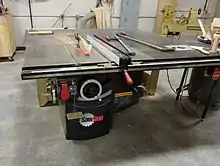SawStop
SawStop is a table saw manufacturer headquartered in Tualatin, Oregon, US. The company was founded in 2000 to sell table saws that feature a patented automatic braking system that stops the blade upon contact. According to an NPR article in 2017, roughly 10 table saw finger amputations occur daily in the United States.[1]
 | |
| Industry | Manufacturing |
|---|---|
| Founded | 2000 |
| Headquarters | Tualatin, Oregon, US 45.3841°N 122.77549°W |
Key people | Steve Gass, David Fanning, and David Fulmer (cofounders) |
| Products | Table saws |
| Website | www |
Product

The manufacture states the saw stops in less than five milliseconds,[2] and angular momentum retracts the blade into the table. The operator suffers a minor instead of serious injury.[3] The design takes advantage of the difference in conductance and capacitance between wood and flesh.[4]
An oscillator generates a 12-volt, 200-kilohertz (kHz) pulsed electrical signal, which is applied to a small plate on one side of the blade. The signal is transferred to the blade by capacitive coupling. A plate on the other side of the blade picks up the signal and sends it to a threshold detector. If a human contacts the blade, the signal will fall below the threshold. After signal loss for 25 micro seconds (µs), the detector will fire. A tooth on a 10-inch circular blade rotating at 4000 RPM will stay in contact with the approximate width of a fingertip for 100 µs. The 200-kHz signal will have up to 10 pulses during that time, and should be able to detect contact with just one tooth.[5] When the brake activates, a spring pushes an aluminum block into the blade. The block is normally held away from the blade by a wire, but during braking an electric current instantly melts the wire, similar to a fuse blowing.
Limitations
According to SawStop, the system has restrictions and limitations:[6]
- The braking system must be deactivated when cutting very green or wet timber.
- Non-conductive blades or blades with non-conductive hubs or teeth cannot be used.
- The braking system is designed to work with kerfs from 3/32″ to 3/16″; using thinner or thicker kerfs limits the saw's ability to stop the blade after accidental contact, likely resulting in more serious injury.
- It is impractical to retrofit into existing table saws.[6]
- Activating the braking system damages the blade.[6]
History
Stopping the blade...would require a two-part process. First, [Gass] needed a brake that would work quickly enough when it came into contact with a woodworker's hand. Next, he had to design a triggering system that could differentiate between finger and wood. Given the speed of the blade, it would have to stop in about 1/100 of a second — or at about an eighth of an inch of rotation after making contact. Any further, and the cut would be so deep that the device would be useless. To stop the blade this quickly would require about 1,000 pounds of force to decelerate the blade in 10 milliseconds.
Invention (1999)


Steve Gass, a patent attorney and amateur woodworker with a doctorate in physics,[7] came up with the idea for SawStop's braking system in 1999.[8] It took Gass two weeks to complete the design, and a third week to build a prototype based on a "$200 secondhand table saw."[7] After numerous tests using a hot dog as a finger-analog, in spring 2000, Gass conducted the first test with a real human finger: he applied Novocain to his left ring finger, and after two false starts, he placed his finger into the teeth of a whirring saw blade. The blade stopped as designed, and although it "hurt like the dickens and bled a lot," his finger remained intact.[7]
Prototype and founding of company (2000)
SawStop, at the time consisting of "three guys out of a barn in Wilsonville", demonstrated a prototype in August 2000[7] at the International Woodworking Machinery and Furniture Supply Fair trade show.[8] A series of meetings followed, in which Gass "negotiated with major players such as Ryobi, Delta, Black & Decker, Emerson, and Craftsman" in an attempt to license his invention; he followed those negotiations with a February 2001 presentation to the Defense Research Industry, a trade group for attorneys representing the power-tool industry.[7] That presentation immediately preceded one from Dan Lanier, Black & Decker's national coordinating counsel; Lanier's presentation gave Gass the impression he was unlikely to succeed in convincing major power tool manufacturers to license SawStop technology.[7]
In July 2001, SawStop was awarded a safety commendation by the US Consumer Product Safety Commission (CPSC) for "developing innovative safety technology for power saws intended to prevent finger amputations and other serious injuries."[3] In 2002 Popular Science named SawStop's technology one of its "100 Best New Innovations."[9]
Attempt to license (2002)
In January 2002, SawStop appeared to come close to a licensing agreement with Ryobi, who agreed to terms that involved no up-front fee and a 3% royalty based on the wholesale price of all saws sold with SawStop's technology; the royalty would grow to 8% if most of the industry also licensed the technology.[7] According to Gass, when a typographical error in the contract had not been resolved after six months of negotiations, Gass gave up on the effort in mid-2002.[10] Subsequent licensing negotiations were deadlocked when the manufacturers insisted that Gass should "indemnify them against any lawsuit if SawStop malfunctioned"; Gass refused because he would not be manufacturing the saws.[7]
Start of manufacturing (2004)
The company's failure to license the technology to any manufacturer prompted SawStop to become a manufacturing company itself; over two years later, the company's first saw was produced by a Taiwanese manufacturing plant in November 2004. By 2005, SawStop had grown to "eight people out of a two-story barn Gass built himself."[7]
Citing statistics showing accidents in the US with table and bench saws resulted in 3000 amputations annually of one or more fingers, SawStop's technology inspired Representative Kevin Joyce to propose the Illinois General Assembly's 2005 Electrical Saw Safety Act.[11] The number of finger or hand amputations in the US has more recently been estimated to be 4000 annually,[12] costing more than $2 billion a year to treat victims.[7][13]
In June 2006, the CPSC recommended that the US government begin the rulemaking process that could result in mandatory safety standards for table saws.
Product liability litigation against Ryobi and other saw manufacturers (2006)
Gass served as an expert trial witness in 2006 when Carlos Osorio sued Ryobi for injuries sustained when he was injured using a Ryobi table saw. Osorio claimed the saw could have been made safer if it had used Gass's invention. Gass also worked with plaintiffs on other table saw lawsuits.[14]
Opposition from trade group (2008)
SawStop has provoked opposition from the Power Tool Institute (PTI),[12] which represents Black & Decker, Hilti, Hitachi Koki, Makita, Metabo, Bosch, Techtronic Industries (owner of Ryobi), and Walter Meier Holdings (WMH Tool Group, owner of JET and Powermatic[15]). In April 2008, they told Congress that SawStop's braking system is:[16]
- dangerous because it requires the user to come in contact with the blade before activating;
- unproven, particularly in terms of durability;
- prone to false trips caused by commonly available wet and green wood;
- potentially vulnerable to latent damage that cannot be inspected and may cause a hazard;
- costly to the user because once activated, saw blade and cartridge must be replaced; and
- significantly more expensive, costing at least 25 percent more than a standard saw and ranging upwards depending on saw type
The PTI objects to the licensing necessary due to the "more than 50 patents" related to SawStop's braking system;[16] they say such costs "would destroy the market for the cheapest, most popular saws, adding $100 or more to the price of consumer models that typically sell for less than $200."[12] In response, their members developed "new plastic guards to shield table saw users from the dangers of a spinning blade" and began selling models with that feature in 2007; as of May 2011, PTI says "its member companies have received no reports of injuries on [the 750,000] table saws with the new guard design."[13]
The Power Tool Institute is also concerned that SawStop patented technology might force other manufacturers to pay unreasonable royalties to SawStop. The Institute also suggests that SawStop users have become less careful, because they have a "sense of security" in the ability of SawStop to protect them, a behavior called risk compensation.[17]
Underwriters Laboratory analysis (2014)
In 2014, Underwriters Laboratory (UL) analyzed table saw accident data and conducted experiments to determine the circumstances that may result in contact with a spinning blade.[18]
Competition appears (2015)
Bosch began manufacturing a competing product, the Bosch REAXX Jobsite Table Saw, which also has finger-saving ability, but using a different technology. Bosch's new REAXX contractor's table saw appeared at the World of Concrete trade show in Las Vegas in February 2015.[19] The Bosch saw retracts the blade below the table, but unlike SawStop, it does not stop or damage the blade.
Pro Tool Reviews published an article comparing the SawStop Jobsite Table Saw with the Bosch REAXX Jobsite Table Saw. They found both saws to be extremely well designed and built, and having many features desirable to contractors. They also found the SawStop made two minor scratches on a finger before stopping, and the Bosch safety saw made four minor scratches. Both saws seem able to save fingers.[20]
Patent litigation (2016)
In September 2016, Judge Thomas B. Pender made an initial determination that the new Bosch design infringes on patents 7,895,927 and 8,011,279 held by SawStop, but does not infringe on two other SawStop patents, 7,225,712 and 7,600,455.[21][22] In February 2017, the ruling entered a 60-day review period, giving attorneys time to comment before it would become final.[23]
In a separate legal action, Bosch attempted to have the SawStop patents invalidated. On March 31, 2017, the Patent Trial and Appeal Board denied Bosch the institution of Inter Partes Review (IPR), thereby leaving the SawStop patents in force.[24]
Consumer Product Safety Commission hearings (2017)
On August 9, 2017, the Consumer Product Safety Commission (CPSC) again held hearings on table saw safety. Despite statements made by the saw industry claiming they are making their saws safer, without resorting to a finger detection technology, injuries and amputations continue to rise, and now stand at over 4000 per year.
Because of intensive lobbying by the saw industry, the House Appropriations Committee attempted to forbid the Consumer Product Safety Commission from passing new rules on saw safety.[1]
As of May 2018 CPSC still has not announced a decision.[25]
New ownership by TTS Holding (2017)
Since July 2017, SawStop is owned by TTS Tooltechnic Systems Holding AG (Germany), which also owns Festool. Consequently, Festool offers saws with SawStop technology.[26]
Patent expiration (2021)
The SawStop patents begin to expire in August 2021, with filed extensions this could extend until April 2024 for the early patents. Given that there are about 100 patents, patent protection for this product line may continue for some years.
See also
- Riving knife explains some of the hazards of table saws.
References
- Chris Arnold (August 10, 2017). "Despite Proven Technology, Attempts To Make Table Saws Safer Drag On". Retrieved August 11, 2017.
- "How It Works". SawStop. Retrieved April 3, 2017.
- "CPSC Chairman Awards Safety Commendation to SawStop, LLC". Washington, DC: Consumer Product Safety Commission. July 20, 2001. Retrieved 2011-06-19.
- Jason Ford (10 July 2001). "SawStop makes for safer woodworking". The Engineer. Archived from the original on December 11, 2018. Retrieved 2011-06-29.
- US 8438958
- "FAQ". SawStop. Retrieved 2011-06-19.
- Melba Newsome (July 2005). "He Took On the Whole Power-Tool Industry". Inc. Retrieved 2013-06-06.
- Charles J. Murray (September 3, 2006). "Man on a Mission". Design News. Retrieved 2011-06-19.
- "Requesting the Consumer Product Safety Commission To Initiate Rulemaking for Table Saws" (PDF). Petition. Consumer Product Safety Commission. April 15, 2003. Retrieved 2011-06-29.
- Myron Levin (May 16, 2013). "After More Than a Decade and Thousands of Disfiguring Injuries, Power Tool Industry Still Resisting Safety Fix". FairWarning. Retrieved February 25, 2017.
- "HB0450". Illinois General Assembly. 2005. Retrieved 2011-06-19.
- Jeff Plungis (June 9, 2011). "Consumer Safety: A Fight Over Table Saws". Bloomberg Businessweek. Retrieved 2011-06-29.
- Jennifer C. Kerr (May 25, 2011). "New rules for table saws sought to cut amputations". Salon.com. Associated Press. Retrieved 2011-06-29.
- Nicholas E. Wheeler. "SawStop Table Saw Litigation: Three Key Takeaways for the Product Liability Practitioner" (PDF). Cosgrave Vergeer Kester LLP. Retrieved February 24, 2017.
- MICHAEL DRESDNER (October 25, 2005). "JET, POWERMATIC AND WILTON: THE WMH TOOL GROUP". Woodworker's Journal. Retrieved March 27, 2017.
- Susan M. Young (April 10, 2008). "The Power Tool Institute's Comments Opposing H.R. 4783" (PDF). House Committee on Ways and Means. Retrieved 2011-06-19.
- "Table Saw Facts at a Glance". Power Tool Institute. Retrieved April 21, 2017.
- "Table Saw Hazard Study on Finger Injuries Due to Blade Contact" (PDF). Underwriters Laboratory. January 2014. Retrieved February 24, 2017.
- CHRIS MARSHALL (May 17, 2016). "BOSCH, SAWSTOP EMBROILED IN REAXX TABLE SAW LAWSUIT". Woodworker's Journal. Retrieved February 25, 2017.
- Kenny and Clint (September 12, 2016). "Tailgate Talk: Bosch Reaxx vs SawStop Table Saws". Pro Tool Reviews. Retrieved March 31, 2017.CS1 maint: uses authors parameter (link)
- Patrick McCombe (September 13, 2016). "SawStop Claims Victory in Lawsuit with Bosch". FineHomebuilding. Retrieved February 24, 2017.
- (United States International Trade Commission September 9, 2016).Text
- Kenny Koehler (February 7, 2017). "SawStop Vs Bosch Reaxx Lawsuit: It's Not Over Yet – UPDATED". Pro Tool Reviews. Retrieved March 21, 2017.
- Jung, Daniels, Kinder (March 31, 2017). "Denying Institution of Inter Partes Review 37 C.F.R. § 42.108" (PDF). Retrieved April 19, 2017.CS1 maint: uses authors parameter (link)
- Amy Livingston (May 11, 2018). "Buying Guide: Table Saws". consumersearch. IAC Publishing, LLC. Retrieved December 14, 2018.
- "Sawstop". www.festool.com. Retrieved 2020-08-30.
External references
- Infringing patent US7895927 Power equipment with detection and reaction systems, filed May 19, 2010
- Infringing patent US8011279 Power equipment with systems to mitigate or prevent injury, filed December 17, 2007
- Non-infringing patent US7225712 Motion detecting system for use in a safety system for power equipment, filed August 13, 2001
- Non-infringing patent US7600455 Logic control for fast-acting safety system, filed August 13, 2001
